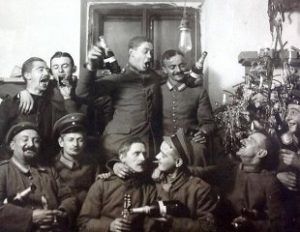Edward B. Westermann in Alternet:
 It was noon in early 1942 as Johann Grüner approached the ‘German House’ in the Polish town of Nowy Targ for lunch. As a mid-level Nazi bureaucrat in occupied Poland, he enjoyed the privileges of power and the opportunity for career advancement that came with duty in the East. The German House, a mix of cultural centre, restaurant and pub, was one of the privileges enjoyed by the occupiers. As he entered the building, he could hear a boisterous celebration within. At the front door, a clearly inebriated Gestapo official passed by, a beer coaster with the number 1,000 written in red pinned to his blouse. Addressing Grüner, the policeman drunkenly bragged: ‘Man, today I am celebrating my 1,000th execution!’
It was noon in early 1942 as Johann Grüner approached the ‘German House’ in the Polish town of Nowy Targ for lunch. As a mid-level Nazi bureaucrat in occupied Poland, he enjoyed the privileges of power and the opportunity for career advancement that came with duty in the East. The German House, a mix of cultural centre, restaurant and pub, was one of the privileges enjoyed by the occupiers. As he entered the building, he could hear a boisterous celebration within. At the front door, a clearly inebriated Gestapo official passed by, a beer coaster with the number 1,000 written in red pinned to his blouse. Addressing Grüner, the policeman drunkenly bragged: ‘Man, today I am celebrating my 1,000th execution!’
At first glance, the incident at the German House might appear to be a grotesque aberration involving a single depraved Nazi killer. However, such ‘celebrations’ were widespread in the occupied Eastern territories as members of the notorious Schutzstaffel (SS) and the German police routinely engaged in celebratory rituals after mass killings. In fact, among the perpetrators of genocide, heavy drinking was common at the killing sites, in pubs and on bases throughout Poland and the Soviet Union. In another horrific example, a group of policemen charged with the cremation of some 800 Jewish corpses used the occasion to tap a keg. In this case, one of the men, named Müller, had the ‘honour’ of setting fire to ‘his Jews’ as he and his colleagues sat around the fire drinking beer. In a similar case, a Jewish woman recalled the aftermath of a killing operation at Przemyśl in Poland: ‘I smelled the odour of burning bodies and saw a group of Gestapo men who sat by the fire, singing and drinking.’ For these Gestapo men, ‘victory celebrations’ proved to be the order of the day, and followed every killing action or ‘liberation from the Jews’.
More here.
